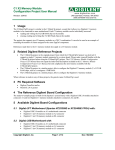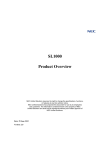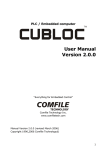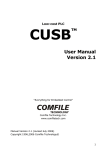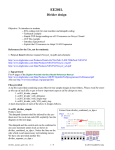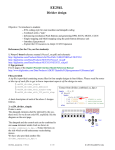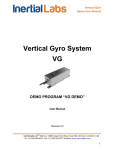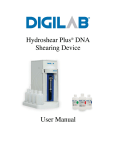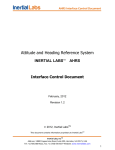Download C3 Memory Module Configuration Project User Manual 1 Usage 2
Transcript
C3 Memory Module Configuration Project User Manual Revision: 3/20/05 TM www .d ig ilen tinc .c om 246 East Main | Pullman, WA 99163 (509) 334 6306 Voice and Fax 1 Usage The Digilent C3 memory module configuration project provides erasing, reading, and writing functions for the 1 MB Flash chip on the module. 2 Related Digilent Reference Projects • • • The C1MemCfg project is a similar project able to configure the Digilent C1 memory module (512 KB RAM + 512 KB Flash) or the C0 memory module (128 KB RAM + 512 KB Flash). The C2MemCfg project is a similar project able to configure the Digilent C2 memory module (2 x 512 KB RAM chips, seen as a contiguous 1 MB RAM). The C1MemCfgX2 project is an example of modifying the C1MemCfg project to support two C1 memory modules connected to the same system board and configured through the same connection and communication module. It can be used as model for custom projects able to support up to five Cx memory modules (identical or different). The maximum number of memory modules is one less than the number of available system board connectors. When reference is made to any of these projects, the generic name CxMemCfg is used. 3 PC Required Software • • Digilent TransPort and/or MemUtil 4 The Reference Digilent Board Configuration The ready-to-compile project is built for Spartan 3 system board with a Digilent USB 2.0 module attached to connector A1 and a Digilent C3 memory module attached to connector A2. 5 Available Digilent Board Configurations Compiled Bit_files and Board_Specific_Source_Files are available for: 5.1 Digilab 2FT Motherboard (Spartan XC2S300E or XC2S400E FPGA) with: • • • 5.2 Digilent USB 2.0 module on A1 connector Digilent C3 memory module on A2 connector Digilab Digital I/O 4 on C1, C2 connectors (optional: used by Main.bit, not used by C3MemCfg.bit – see section 6) Digilab 2SB Motherboard with: • • • 5.3 Digilent USB 2.0 module on A1 connector Digilent C3 memory module on A2 connector Digilab Digital I/O 4 on C1, C2 connector (optional: used by Main.bit, not used by C3MemCfg.bit – see section 6) Digilent Pegasus Motherboard (Spartan XC2S50 or XC2S200 FPGA) with: • • Digilent USB 2.0 Module on A1 motherboard connector Digilent C3 memory module on A2 connector Copyright Digilent, Inc. Page 1 of 14 Doc: 562-004 Digilent, IncTM C3MemCfg User Manual 5.4 www.digilentinc.com Digilent Spartan 3 Motherboard (Spartan XC3S200 or XC3S400 FPGA) with: • • Digilent USB 2.0 module on A1 motherboard connector Digilent C3 memory module on A2 connector 6 Available Project and Compiling Variants • • with 7-segment display showing the lower 16 memory address bus bits (Main.bit) without display (C3MemCfg.bit) Choosing Main.sch as the highest level file in the project hierarchy, the project enables the display feature. The Digilab Digital I/O 4 board should be part of the configuration or the motherboard should have the 4-digit, 7segment display on it. The compiled file is Main.bit. Choosing C3MemCfg.sch as the highest level file in the project hierarchy disables the display feature, releasing the associated resources (pins, internal logic). This can be done even if the whole project includes the Main.sch file, and C3MemCtrl is displayed as a lower level hierarchical file: just highlight C3MemCtrl in the “Sources in Project” and generate the programming file C3Memcfg.bit. 7 Digilent Library Components Used • • • C3MemCtrl EppCtrl Disp7sCtrl 8 Project Description The project implements an EPP interface (EppCtrl), able to communicate with the EPP port emulated by the Digilent USB 2.0 Module. The EPP interface controls the EPP data registers implemented in the memory module controller (C3MemCtrl). The memory module controller generates the signal sequence needed to erase, read, or write the Flash chip. For detailed descriptions of each component, see the Digilent Component Library. 9 Using Digilent MemUtil Software to Configure the Memory Module Using MemUtil to configure the memory module is very simple and intuitive. You should keep in mind the features provided by the C3 memory module (1 MB Flash). The software functions are: • Properties . The user sets: o Connection Properties. In the pull-down menu, the desired connection is selected. Multiple communication modules (Ethernet, USB, Serial) can be connected at the same time to the host PC. A MemUtil instance uses a single such connection. o Configure. The selected connection can be configured. For more details see the Adept User Manual. o Memory configuration. Selects the Digilent memory module type. The C3MemCfg project works with a single C3 memory module. o Starting Register Address. MemUtil supports multiple memory modules attached to different motherboard connectors. For more details, see the C1memCfgX2 project. For the C3MemCfg project, select 0x00. • Load RAM. This tab is inactive, since the C3 memory module does not contain RAM memory. • Load Flash. The user specifies: o the source file o the File Start Location o the Flash start address o the length of transferred data block o the Verify option Copyright Digilent, Inc. Page 2 of 14 Doc: 562-004 Digilent, IncTM C3MemCfg User Manual o www.digilentinc.com the Auto erase option. The software erases only the Flash block which are affected by the Load operation. • Store RAM. This tab is inactive, since C3 memory module does not contain RAM memory. • Store Flash. The user specifies: o the Flash start address o the length of transferred data block o the destination file o the file write option (Append, Replace, Overwrite) o the File Start Location (only for Overwrite) • Ease Flash. The user specifies: o the blocks selected for erase operation o type of operation (Erase All or Erase Selected) Multiple instances of MemUtil can run at the same time, on the same PC, sharing the same connection, communication module, system board, and memory module. Other Digilent applications (such as Digilent TransPort and Digilent ExPort) can also share the same connection. The MemUtil instances sharing the same connection can share the same memory module or be assigned to different memory modules. On the other hand, the C3MemCfg project only supports a single C3 memory module. Memory modules are identified by the starting register address. The C3MemCfg project assigns the starting register address 0x00 to the memory module. Successive operations can be launched through any active MemUtil instance. The user should allow a command to be fully executed before launching another one for the same communication module. To control multiple memory modules connected to the same system board (and through the same connection and communication module), the CxMemCfg project needs to be modified. An example is the C1MemCfgX2 project. For more information, see the C1 Memory Module Configuration X2 Project User Manual. Multiple MemUtil instances can be used to control different board sets. For example, multiple different USB channels can be connected each to its own set (USB Module + System Board + Memory Module). Each system board needs to be configured with a CxMemCfg project. In this case, MemUtil instances are set to use different connections. 10 Using Digilent TranSport Software to Configure the Memory Module The Transport software allows the user to access the memory module at lower level commands. The routines are the same as the ones used by MemUtil, to implement the high level commands described above. TranSport is useful for debugging purposes and for checking the command sequences before implementing them in a user generated software application. The software functions are: • Properties . The user sets: o Connection Properties. In the pull-down menu, the desired connection is selected. Multiple communication modules (Ethernet, USB, Serial), can be connected at the same time to the host PC. A MemUtil instance uses a single such connection. o Configure. The selected connection can be configured. For more information, see the Adept User Manual. • Load File. Sends a file (fragment) to a specified EPP Data Register. The user specifies: o the source file Copyright Digilent, Inc. Page 3 of 14 Doc: 562-004 Digilent, IncTM C3MemCfg User Manual o o o o www.digilentinc.com the File Start Location the Destination Register the Load Entire File option the length of transferred data block (only if the Load Entire File option is not checked) • Store File. Reads a specified EPP Data Register and saves data to a file (fragment). The user specifies: o the destination file o the File Output Mode (Append, Replace, Overwrite) o the File Start Location (only for Overwrite) o the Source Register o the length of transferred data block • Register I/O. Reads or writes a byte from/to a specified EPP Data Register. The user specifies: o the Epp Register Address o the data (for write operations) o the read Display Format There are 8 lines, each able to define a register address and data. Their transfer can be performed line by line (pressing the Read or Write button of the desired line) or as full sequence, pressing the Read All or Write All buttons. Multiple instances of TransPort can run at the same time, on the same PC, sharing the same connection, communication module, system board, and memory module. Other Digilent applications (such as MemUtil and ExPort) can also share the same connection. The TransPort instances sharing the same connection can share the same memory module or be assigned to different memory modules. On the other hand, the C2MemCfg project only supports a single C3 memory module. Memory modules are identified by the Register Address range. The C3MemCfg project assigns the Register Address range 0x00 ...0x07 to the memory module. Successive operations can be launched through any active TransPort instance. The user should however allow a command to be fully executed before launching another one for the same communication module. To control multiple memory modules connected to the same system board (and through the same connection and communication module), the CxMemCfg project needs to be modified. An example is the C1MemCfgX2 project. For more details see the C1Memory Configuration X2 Project User Manual. Multiple TransPort instances can be used to control different board sets. For example, multiple different USB channels can be connected each to its own set (USB Module + System Board + Memory Module). Each system board needs to be configured with a CxMemCfg project. In this case, TransPort instances are set to use different connections. As described above, TransPort software can be used to control any EPP interface implemented in the FPGA circuit. The following section shows how to access the specific C3 memory module features. 10.1 Reading a Flash Location with Low-Level EPP Commands Before attempting to read the Flash memory, make sure the Flash is in the Array Read mode. The Flash chip can be set in Array Read mode by either of the following actions: • • • Power up reset Activate the Reset pin (RP) (active LOW) Issue the READ ARRAY command. Once in READ ARRAY mode, the Flash chip holds that mode until a different command is sent. Copyright Digilent, Inc. Page 4 of 14 Doc: 562-004 Digilent, IncTM C3MemCfg User Manual www.digilentinc.com If the Flash chip is already in READ ARRAY mode, skip the steps 1 to 2. 1. Load Read Array command to the Memory Data Bus Register MemDB(7 downto 0)): 1.1. Write the Read Array command (FFh) to EPP Register regMemWrData(7 downto 0) at EPP address MemDataWr = 4 2. Generate the write sequence on the memory control bus: 2.1. Activate FlashCS and MemWr signals - write “10101” to the regMemCtl(4 downto 0), at EPP address MemCtrlReg = 0) 2.2. Deactivate MemWr signal - write “10111” to the regMemCtl(4 downto 0), at EPP address MemCtrlReg = 0) 2.3. Deactivate FlashCS signal - write “11111” to the regMemCtl(4 downto 0), at EPP address MemCtrlReg = 0) 3. Load the Memory Address Bus Register (MemAdr(19 downto 0)): 3.1. Write the lowest address byte to EPP Register MemAdr(7 downto 0) at EPP address MemAdrL = 1 3.2. Write the middle address byte to EPP Register MemAdr(15 downto 8) at EPP address MemAdrM = 2 3.3. Write the highest address byte to EPP Register MemAdr(19 downto 16) at EPP address MemAdrH = 3 (for bytes keeping the previous value, the steps above can be skipped) 4. Generate the read sequence on the memory control bus: 4.1. Activate FlashCS and MemOE signals - write “10110” to the regMemCtl(4 downto 0), at EPP address MemCtrlReg = 0) 5. Read the Memory Data Bus Register MemDB(7 downto 0)): 5.1. Read the EPP Register regMemRdData(7 downto 0) at EPP address MemDataRd = 5 6. Finish the read sequence on the memory control bus: 6.1. Deactivate FlashCS and MemOE signals - write “11111” to the regMemCtl(4 downto 0), at EPP address MemCtrlReg = 0) 10.2 Writing a Flash Location with Low-Level EPP Commands The user directly controls the memory busses (Data, Address and Control), using the Register I/O function: 1. Load the Memory Address Bus Register (MemAdr(19 downto 0)): 1.1. Write the lowest address byte to EPP Register MemAdr(7 downto 0) at EPP address MemAdrL = 1 1.2. Write the middle address byte to EPP Register MemAdr(15 downto 8) at EPP address MemAdrM = 2 1.3. Write the highest address byte to EPP Register MemAdr(19 downto 16) at EPP address MemAdrH = 3 (for bytes keeping the previous value, the steps above can be skipped) 2. Load Write Command to the Memory Data Bus Register MemDB(7 downto 0)): 2.1. Write the Write Command (40h) to EPP Register regMemWrData(7 downto 0) at EPP address MemDataWr = 4 3. Generate the write sequence on the memory control bus: 3.1. Activate FlashCS and MemWr signals - write “10101” to the regMemCtl(4 downto 0), at EPP address MemCtrlReg = 0) 3.2. Deactivate MemWr signal - write “10111” to the regMemCtl(4 downto 0), at EPP address MemCtrlReg = 0) 3.3. Deactivate FlashCS signal - write “11111” to the regMemCtl(4 downto 0), at EPP address MemCtrlReg = 0) 4. Load data to the Memory Data Bus Register MemDB(7 downto 0)): 4.1. Write the data byte to EPP Register regMemWrData(7 downto 0) at EPP address MemDataWr = 4 5. Generate the write sequence on the memory control bus: 5.1. Activate FlashCS and MemWr signals - write “10101” to the regMemCtl(4 downto 0), at EPP address MemCtrlReg = 0) 5.2. Deactivate MemWr signal - write “10111” to the regMemCtl(4 downto 0), at EPP address MemCtrlReg = 0) 5.3. Deactivate FlashCS signal - write “11111” to the regMemCtl(4 downto 0), at EPP address MemCtrlReg = 0) Copyright Digilent, Inc. Page 5 of 14 Doc: 562-004 Digilent, IncTM C3MemCfg User Manual www.digilentinc.com When manually writing a data byte using TransPort software, the steps 6 to 13 are not necessary (in fact, it’s not possible to perform them fast enough.) They check a status bit of the Flash chip, which pulses low, while the internal Flash logic performs the write operation. Typical pulse length is 2µs. The steps are posted here as a reference to be implemented in a software or HDL component, which automatically performs the write sequence. 6. 7. 8. 9. 10. 11. 12. 13. Generate the read sequence on the memory control bus: 6.1. Activate FlashCS and MemOE signals - write “10110” to the regMemCtl(4 downto 0), at EPP address MemCtrlReg = 0) Read the Flash Status Register (SR) on the Memory Data Bus Register MemDB(7 downto 0)): 7.1. Read the EPP Register regMemRdData(7 downto 0) at EPP address MemDataRd = 5 Finish the read sequence on the memory control bus: 8.1. Deactivate FlashCS and MemOE signals - write “11111” to the regMemCtl(4 downto 0), at EPP address MemCtrlReg = 0) Check the SR7 bit (MSB of SR). Loop back to 6, if SR7 = 1. Generate the read sequence on the memory control bus: 10.1. Activate FlashCS and MemOE signals - write “10110” to the regMemCtl(4 downto 0), at EPP address MemCtrlReg = 0) Read the Flash Status Register (SR) on the Memory Data Bus Register MemDB(7 downto 0)): 11.1. Read the EPP Register regMemRdData(7 downto 0) at EPP address MemDataRd = 5 Finish the read sequence on the memory control bus: 12.1. Deactivate FlashCS and MemOE signals - write “11111” to the regMemCtl(4 downto 0), at EPP address MemCtrlReg = 0) Check the SR7 bit (MSB of SR). Loop back to 10 , if SR7 = 0. 10.3 Erasing a Flash Block with Low-Level EPP Commands The user directly controls the memory busses (Data, Address and Control), using the Register I/O function: 1. Load the Memory Address Bus Register (MemAdr(19 downto 0)) – any address in the block to be erased: 1.1. Write the lowest address byte to EPP Register MemAdr(7 downto 0) at EPP address MemAdrL = 1 1.2. Write the middle address byte to EPP Register MemAdr(15 downto 8) at EPP address MemAdrM = 2 1.3. Write the highest address byte to EPP Register MemAdr(19 downto 16) at EPP address MemAdrH = 3 (for bytes keeping the previous value, the steps above can be skipped) 2. Load Erase Command to the Memory Data Bus Register MemDB(7 downto 0)): 2.1. Write the Erase Command (20h) to EPP Register regMemWrData(7 downto 0) at EPP address MemDataWr = 4 3. Generate the write sequence on the memory control bus: 3.1. Activate FlashCS and MemWr signals - write “10101” to the regMemCtl(4 downto 0), at EPP address MemCtrlReg = 0) 3.2. Deactivate MemWr signal - write “10111” to the regMemCtl(4 downto 0), at EPP address MemCtrlReg = 0) 3.3. Deactivate FlashCS signal - write “11111” to the regMemCtl(4 downto 0), at EPP address MemCtrlReg = 0) 4. Load Confirm Erase Command to the Memory Data Bus Register MemDB(7 downto 0)): 4.1. Write the Confirm Erase Command (D0h) to EPP Register regMemWrData(7 downto 0) at EPP address MemDataWr = 4 5. Generate the write sequence on the memory control bus: 5.1. Activate FlashCS and MemWr signals - write “10101” to the regMemCtl(4 downto 0), at EPP address MemCtrlReg = 0) 5.2. Deactivate MemWr signal - write “10111” to the regMemCtl(4 downto 0), at EPP address MemCtrlReg = 0) 5.3. Deactivate FlashCS signal - write “11111” to the regMemCtl(4 downto 0), at EPP address MemCtrlReg = 0) When manually writing a data byte using TransPort software, the steps 6 to 13 are not necessary (in fact, it’s not possible to perform them fast enough.) They check a status bit of the Flash chip, which pulses low, while the internal Copyright Digilent, Inc. Page 6 of 14 Doc: 562-004 Digilent, IncTM C3MemCfg User Manual www.digilentinc.com Flash logic performs the write operation. Typical pulse length is 200-500ms. The steps are posted here as a reference to be implemented in a software or HDL component, which performs automatically the erase sequence. 6. 7. 8. 9. 10. 11. 12. 13. Generate the read sequence on the memory control bus: 6.1. Activate FlashCS and MemOE signals - write “10110” to the regMemCtl(4 downto 0), at EPP address MemCtrlReg = 0) Read the Flash Status Register (SR) on the Memory Data Bus Register MemDB(7 downto 0)): 7.1. Read the EPP Register regMemRdData(7 downto 0) at EPP address MemDataRd = 5 Finish the read sequence on the memory control bus: 8.1. Deactivate FlashCS and MemOE signals - write “11111” to the regMemCtl(4 downto 0), at EPP address MemCtrlReg = 0) Check the SR7 bit (MSB of SR). Loop back to 6, if SR7 = 1. Generate the read sequence on the memory control bus: 10.1. Activate FlashCS and MemOE signals - write “10110” to the regMemCtl(4 downto 0), at EPP address MemCtrlReg = 0) Read the Flash Status Register (SR) on the Memory Data Bus Register MemDB(7 downto 0)): 11.1. Read the EPP Register regMemRdData(7 downto 0) at EPP address MemDataRd = 5 Finish the read sequence on the memory control bus: 12.1. Deactivate FlashCS and MemOE signals - write “11111” to the regMemCtl(4 downto 0), at EPP address MemCtrlReg = 0) Check the SR7 bit (MSB of SR). Loop back to 10 , if SR7 = 0. 10.4 Reading a Flash Location Using the Automatic Flash Read Register Before attempting to read the Flash memory, make sure the Flash is in the Array Read mode. The Flash chip can be set in Array Read mode by either of the following actions: • • • Power up reset Activate the Reset pin (RP) (active LOW) Issue the READ ARRAY command. Once in READ ARRAY mode, the Flash chip holds that mode until a different command is sent. If the Flash chip is not already in READ ARRAY mode, perform first the steps 1 to 2 shown in section 10.1. 1. 2. Load the Memory Address Bus Register (MemAdr(19 downto 0)): 1.1. Write the lowest address byte to EPP Register MemAdr(7 downto 0) at EPP address MemAdrL = 1 1.2. Write the middle address byte to EPP Register MemAdr(15 downto 8) at EPP address MemAdrM = 2 1.3. Write the highest address byte to EPP Register MemAdr(19 downto 16) at EPP address MemAdrH = 3 (for bytes keeping the previous value, the steps above can be skipped) Read the regMemRdData(7 downto 0) register at address RamAutoRW = 7. C3MemCtrl automatically generates the read sequence and increments the MemAdr register. Repeat step 2 to read successive Flash locations. 10.5 Writing a Flash Location Using the Automatic Flash Write Register 1. 2. Load the Memory Address Bus Register (MemAdr(19 downto 0)): 1.1. Write the lowest address byte to EPP Register MemAdr(7 downto 0) at EPP address MemAdrL = 1 1.2. Write the middle address byte to EPP Register MemAdr(15 downto 8) at EPP address MemAdrM = 2 1.3. Write the highest address byte to EPP Register MemAdr(19 downto 16) at EPP address MemAdrH = 3 (for bytes keeping the previous value, the steps above can be skipped) Write data byte to the regMemRdData(7 downto 0) register at address FlashAutoRW = 7. C3MemCtrl automatically generates the write sequence and increments the MemAdr register. Repeat step 2 to write successive Flash locations. The Flash chip enters the READ STATUS mode. Copyright Digilent, Inc. Page 7 of 14 Doc: 562-004 Digilent, IncTM C3MemCfg User Manual www.digilentinc.com 10.6 Storing the Flash Content to a File Using the Store File Function Before attempting to read the Flash memory, make sure the Flash is in the Array Read mode. The Flash chip can be set in Array Read mode by either of the following actions: • • • Power up reset Activate the Reset pin (RP) (active LOW) Issue the READ ARRAY command. Once in READ ARRAY mode, the Flash chip holds that mode until a different command is sent. If the Flash chip is not already in READ ARRAY mode, perform first the steps 1 to 2 shown in section 10.1. 1. 2. Load the Memory Address Bus Register (MemAdr(19 downto 0)): 1.1. Write the lowest address byte to EPP Register MemAdr(7 downto 0) at EPP address MemAdrL = 1 1.2. Write the middle address byte to EPP Register MemAdr(15 downto 8) at EPP address MemAdrM = 2 1.3. Write the highest address byte to EPP Register MemAdr(19 downto 16) at EPP address MemAdrH = 3 (for bytes keeping the previous value, the steps above can be skipped) Select the Store File tab of the TransPort software. Fill in the required fields. Select Source Register 7 (FlashAutoRW). Press the Store button. 10.7 Loading a File to the Flash Using the Load File Function 1. 2. Load the Memory Address Bus Register (MemAdr(19 downto 0)): 1.1. Write the lowest address byte to EPP Register MemAdr(7 downto 0) at EPP address MemAdrL = 1 1.2. Write the middle address byte to EPP Register MemAdr(15 downto 8) at EPP address MemAdrM = 2 1.3. Write the highest address byte to EPP Register MemAdr(19 downto 16) at EPP address MemAdrH = 3 (for bytes keeping the previous value, the steps above can be skipped) Select the Load File tab of the TransPort software. Fill in the required fields. Select Source Register 7 (FlashAutoRW). Press the Load button. The Flash chip enters the READ STATUS mode. Copyright Digilent, Inc. Page 8 of 14 Doc: 562-004 Digilent, IncTM C3MemCfg User Manual www.digilentinc.com 11 EppCtrl State Diagram, State Transition Table, and Signals EppRst stEppReady 000 else eppDstb = '0' or eppAstb = stEppStb 010 else EppDstb = ‘0’ and HandShakeReqIn = ‘1’ stEppSetProc 011 stEppRegTransf 110 stEppLaunchProc 111 else ctlMsmDoneIn = '1' stEppWaitPro c else ctlMsmDoneIn = '0' stEppDone 100 EppAstb = '0' or EppDstb = ‘0’ else State Transition Table 00 01 11 10 Copyright Digilent, Inc. Page 9 of 14 0 Ready ↓ Stb ↓ → RegTransf ↓ Done 1 SetProc ↓ LaunchProc ↓ WaitProc Doc: 562-004 Digilent, IncTM C3MemCfg User Manual www.digilentinc.com 11.1 EppCtrl Port Signals -- EPP-like bus signals clk : in std_logic; -- system clock (50MHz) EppAstb : in std_logic; -- Address strobe EppDstb : in std_logic; -- Data strobe EppWr : in std_logic; -- Port write signal EppRst : in std_logic; -- Port reset signal EppDB : inout std_logic_vector(7 downto 0); -- port data bus EppWait : out std_logic; -- Port wait signal -- User signals busEppOut : out std_logic_vector(7 downto 0);-- Data Output bus busEppIn : in std_logic_vector(7 downto 0); -- Data Input bus ctlEppDwrOut : out std_logic; -- Data Write pulse ctlEppRdCycleOut: inout std_logic;-- Indicates a READ Epp cycle regEppAdrOut : inout std_logic_vector(7 downto 0) := "00000000"; -- Epp Address Register content HandShakeReqIn : in std_logic; -- User Handshake Request ctlEppStartOut : out std_logic; -- Automatic process Start ctlEppDoneIn : in std_logic -- Automatic process Done 11.2 EppCtrl Internal Signals busEppInternal: std_logic_vector(7 downto 0); ctlEppAwr : std_logic; 11.3 EppCtrl Signal Assignments -- Synchronized EPP outputs: process(clk) begin if clk'event and clk='1' then if stEppCur = stEppReady then ctlEppRdCycleOut <= '0'; elsif stEppCur = stEppStb then ctlEppRdCycleOut <= EppWr; state end if; end if; end process; -- not equivalent to EppWr due to default busEppOut <= EppDB; EppDB <= busEppInternal when (ctlEppRdCycleOut = '1') else "ZZZZZZZZ"; busEppInternal <= regEppAdrOut when EppAstb = '0' else busEppIn; -- Epp State machine related signals EppWait <= '1' when stEppCur = stEppDone else '0'; ctlEppAwr <= '1' when stEppCur = stEppRegTransf and EppAstb = '0' and EppWr = '0' else '0'; ctlEppDwrOut <= '1' when (stEppCur = stEppRegTransf or stEppCur = stEppSetProc) and EppDstb = '0' and EppWr = '0' else '0'; ctlEppStartOut <= '1' when stEppCur = stEpplaunchProc else '0'; Copyright Digilent, Inc. Page 10 of 14 Doc: 562-004 Digilent, IncTM C3MemCfg User Manual www.digilentinc.com 12 C3MemCtrl State Diagram, State Transition Table, and Signals Reset stMsmReady 0000 else CtlEppStartIn = ‘1’ and RegEppAdr = FlashAutoRW and ComponentSelect = ‘1’ and CtlEppRdCycleIn = ‘0’ else stMsmFwr01 0001 CtlEppStartIn = ‘1’ and RegEppAdr = FlashAutoRW and DelayCnt = “101” ComponentSelect = ‘1’ and else CtlEppRdCycleIn = ‘1’ stMsmFwr02 0101 stMsmFrd01 0100 DelayCnt = “111” else else stMsmFwr03 DelayCnt = “101” 0111 DelayCnt = “101” stMsmAdInc 1100 stMsmDone 1000 else stMsmFwr04 1111 DelayCnt = “101” and busMemIn(7) = ‘1’ CtlMsmStartIn = ‘’1’ 01 11 10 00 Ready ↓ → Frd01 ↓ AdrInc ↓ Done ↓ 01 Fwr01 11 10 ↓ Fwr02 DelayCnt = “101” and busMemIn(7) = ‘0’ Fwr03 → Fwr07 ↓ ← DelayCnt = “111” else stMsmFwr07 1101 Fwr04 Fwr06 DelayCnt = “111” else stMsmFwr05 1011 DelayCnt = “101” and busMemIn(7) = ‘0’ else stMsmFwr06 1001 State Transition Table 00 else ↓ Fwr05 ↑ Copyright Digilent, Inc. ← DelayCnt = “101” and busMemIn(7) = ‘1’ Page 11 of 14 Doc: 562-004 Digilent, IncTM C3MemCfg User Manual www.digilentinc.com 12.1 C3MemCtrl Port Signals ck : in std_logic; -- system clock (50MHz) -- EPP interface signals HandShakeReqOut: out std_logic; -- User Handshake Request ctlMsmStartIn: in std_logic; -- Automatic process Start ctlMsmDoneOut: out std_logic; -- Automatic process Done ctlMsmDwrIn: in std_logic; -- Data Write pulse ctlEppRdCycleIn: in std_logic; -- Indicates a READ Epp cycle EppRdDataOut: out std_logic_vector(7 downto 0); -- Data Input bus EppWrDataIn: in std_logic_vector(7 downto 0); -- Data Output bus regEppAdrIn: in std_logic_vector(7 downto 0) ; -- Epp Address Register content (bits 7:3 ignored) ComponentSelect : in std_logic; -- active HIGH, selects the current MemCtrl instance -- Memory bus signals MemDB : inout std_logic_vector(7 downto 0); -- Memory data bus MemAdr : out std_logic_vector(19 downto 0); -- Memory Address bus FlashCS : out std_logic; -- Flash CS MemWR : out std_logic; -- memory write MemOE : out std_logic -- memory read (Output Enable), also controls the MemDB direction 12.2 C3MemCtrl Internal Signals signal DelayCnt : std_logic_vector(2 downto 0); -- Signals dealing with memory chips signal regMemCtl: std_logic_vector(4 downto 0) := "11111";-- Memory Control register signal regMemAdr: std_logic_vector(19 downto 0); -- Memory Address register signal carryoutL: std_logic := '0'; -- Carry out for memory address low byte signal carryoutM: std_logic := '0'; -- Carry out for memory address middle byte signal regMemWrData: std_logic_vector(7 downto 0); -- Memory Write Data register signal regMemRdData: std_logic_vector(7 downto 0); -- Memory Read Data register signal busMemIn: std_logic_vector(7 downto 0); signal busMemOut: std_logic_vector(7 downto 0); -- Signals in the memory control register signal ctlMcrOe : std_logic; signal ctlMcrWr : std_logic; signal ctlMcrFlashCs : std_logic; signal ctlMcrDir : std_logic; -- Output enable (read strobe) -- Write enable (write strobe) -- Flash chip select -- composed out of previous ones -- Signals used by Memory control state machine signal ctlMsmOe : std_logic; signal ctlMsmWr : std_logic; signal ctlMsmFlashCs : std_logic; signal ctlMsmDir : std_logic; signal ctlMsmAdrInc : std_logic; signal ctlMsmWrCmd : std_logic; Copyright Digilent, Inc. Page 12 of 14 Doc: 562-004 Digilent, IncTM C3MemCfg User Manual www.digilentinc.com 12.3 C3MemCtrl Signal Assignments -- Memory signals -Memory control register ctlMcrOe <= regMemCtl(0); ctlMcrWr <= regMemCtl(1); ctlMcrFlashCs <= regMemCtl(3); -- Output enable (read strobe) -- Write enable (write strobe) -- Flash chip select -- Memory control bus driven either by automatic state machine or by memory control register FlashCS <= ctlMsmFlashCs and ctlMcrFlashCs; -- PC generated Flash CS; MemWR <= ctlMsmWr and ctlMcrWr; -- PC generated MemWr; MemOE <= ctlMsmOe and ctlMcrOe; -- PC generated MemOe; busMemIn <= MemDB; busMemOut <= "01000000" when ctlMsmWrCmd = '1' else regMemWrData; MemAdr <= regMemAdr; ctlMcrDir <= ctlMcrOe and ((not ctlMcrFlashCs) or (not ctlMcrRAMCs)); MemDB <= busMemOut when (ctlMsmDir = '1' or ctlMcrDir = '1') else "ZZZZZZZZ"; -- Handshake signal HandShakeReqOut <= '1' when (regEppAdrIn(2 downto 0) = FlashAutoRW) and ComponentSelect = '1' else '0'; -- Delay Counter process (clk) begin if clk'event and clk = '1' then if stMsmCur = stMsmReady then DelayCnt <= "000"; else DelayCnt <= DelayCnt + 1; end if; end if; end process; -- Memory Control Register process (clk, ctlMsmDwrIn) begin if clk = '1' and clk'Event then if ctlMsmDwrIn = '1' and regEppAdrIn(2 downto 0) = MemCtrlReg and ComponentSelect = '1' then regMemCtl <= EppWrDataIn(4 downto 0); end if; end if; end process; -- Memory Address Register/Counter MsmAdrL: process (clk, ctlMsmDwrIn, ctlMsmAdrInc) begin if clk = '1' and clk'Event then if ctlMsmAdrInc = '1' then regMemAdr(7 downto 0) <= regMemAdr(7 downto 0) + 1; --"00000001"; elsif ctlMsmDwrIn = '1' and regEppAdrIn(2 downto 0) = MemAdrL and ComponentSelect = '1' then regMemAdr(7 downto 0) <= EppWrDataIn; end if; end if; Copyright Digilent, Inc. Page 13 of 14 Doc: 562-004 Digilent, IncTM C3MemCfg User Manual www.digilentinc.com end process; carryoutL <= '1' when regMemAdr(7 downto 0) = "11111111" else '0'; MsmAdrM: process (clk, ctlMsmDwrIn, ctlMsmAdrInc) begin if clk = '1' and clk'Event then if ctlMsmAdrInc = '1' and carryoutL = '1' then regMemAdr(15 downto 8) <= regMemAdr(15 downto 8) + 1; --"00000001"; elsif ctlMsmDwrIn = '1' and regEppAdrIn(2 downto 0) = MemAdrM and ComponentSelect = '1' then regMemAdr(15 downto 8) <= EppWrDataIn; end if; end if; end process; carryoutM <= '1' when regMemAdr(15 downto 8) = "11111111" else '0'; MsmAdrH: process (clk, ctlMsmDwrIn, ctlMsmAdrInc) begin if clk = '1' and clk'Event then if ctlMsmAdrInc = '1' and carryoutL = '1' and carryoutM = '1' then regMemAdr(19 downto 16) <= regMemAdr(19 downto 16) + 1; --"001"; elsif ctlMsmDwrIn = '1' and regEppAdrIn(2 downto 0) = MemAdrH and ComponentSelect = '1' then regMemAdr(19 downto 16) <= EppWrDataIn(2 downto 0); end if; end if; end process; -- Memory write data holding register process (clk, ctlMsmDwrIn) begin if clk = '1' and clk'Event then if ctlMsmDwrIn = '1' and (regEppAdrIn(2 downto 0) = FlashAutoRW or regEppAdrIn(2 downto 0) = MemDataWr) and ComponentSelect = '1' then regMemWrData <= EppWrDataIn; end if; end if; end process; -- Memory read register: - holds data after an automatic read process (clk) begin if clk = '1' and clk'Event then if stMsmCur = stMsmFrd01 then regMemRdData <= busMemIn; end if; end if; end process; Copyright Digilent, Inc. Page 14 of 14 Doc: 562-004














